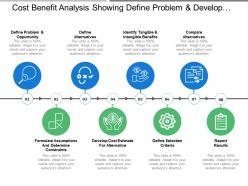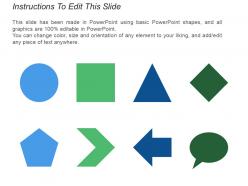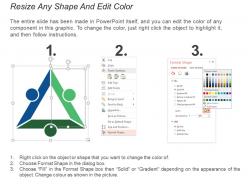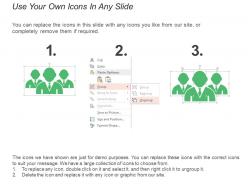Cost benefit analysis showing define problem and develop cost estimate
Cultivate green habits with our Cost Benefit Analysis Showing Define Problem And Develop Cost Estimate. They will benefit our ecosystem.
You must be logged in to download this presentation.
 Impress your
Impress your audience
Editable
of Time
PowerPoint presentation slides
Presenting this set of slides with name - Cost Benefit Analysis Showing Define Problem And Develop Cost Estimate. This is a eight stage process. The stages in this process are Cost Benefit Analysis, Cost Benefit Investigation, Cost Benefit Examination.
People who downloaded this PowerPoint presentation also viewed the following :
Content of this Powerpoint Presentation
Description:
The image shows a PowerPoint slide titled "Cost Benefit Analysis Showing Define Problem & Develop...". It presents an eight-step process, each step represented by a numbered circle and accompanied by an icon, along with text boxes for further elaboration:
1. Define Problem & Opportunity:
Involves clarifying the issue or chance at hand, symbolized by a light bulb icon, suggesting the generation of ideas or identification of key issues.
2. Define Alternatives:
Entails outlining possible solutions or courses of action, indicated by a two-way arrow icon, representing choices or different paths.
3. Identify Tangible & Intangible Benefits:
This step is about recognizing both the measurable and less quantifiable advantages of each alternative, depicted by a hand with a coin symbol, which suggests value assessment.
4. Formulate Assumptions And Determine Constraints:
Involves setting the parameters within which the analysis will operate, symbolized by a square root sign, possibly indicating the need to delve into the foundational elements of the problem.
5. Develop Cost Estimate For Alternative:
Entails calculating the financial implications of each option, illustrated by a dollar sign and a calculator, emphasizing the cost analysis aspect.
6. Define Selection Criteria:
This step is about establishing the metrics or standards by which the alternatives will be judged, represented by a cog icon, which could symbolize the mechanism of decision-making.
7. Compare Alternatives:
Involves evaluating the options against each other based on the defined criteria, denoted by a comparison chart icon, indicating the analysis and contrast of different solutions.
8. Report Results:
The final step is to document and present the findings of the analysis, symbolized by a clipboard icon, which typically represents reporting or summarization of data.
Use Cases:
This slide can be effectively used in various industries for analytical and decision-making processes:
1. Finance:
Use: Evaluating investment options.
Presenter: Financial Analyst
Audience: Investors, executive management
2. Government:
Use: Policy analysis and public project evaluations.
Presenter: Policy Advisor
Audience: Government officials, public stakeholders
3. Healthcare:
Use: Analyzing new medical treatments or technology investments.
Presenter: Healthcare Administrator
Audience: Hospital board, medical staff
4. Technology:
Use: Assessing new technology projects or product developments.
Presenter: Chief Technology Officer
Audience: Project team, stakeholders
5. Education:
Use: Deciding on educational programs or infrastructure projects.
Presenter: Education Planner
Audience: School board, faculty
6. Construction:
Use: Weighing project bids or material selections.
Presenter: Construction Manager
Audience: Project stakeholders, clients
7. Manufacturing:
Use: Considering efficiency improvements or equipment purchases.
Presenter: Operations Manager
Audience: Management team, operations staff
Cost benefit analysis showing define problem and develop cost estimate with all 5 slides:
Our Cost Benefit Analysis Showing Define Problem And Develop Cost Estimate guarantee elation. They are a cause of great happiness.
-
Great designs, really helpful.
-
Colors used are bright and distinctive.

















